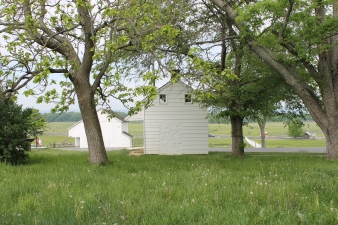At the northern end of Hancock Avenue, almost at the very tip of Cemetery Ridge, is a small, inconspicuous, white-washed farmhouse. With only two rooms, along with an upstairs loft, the home makes Lydia Leister’s more famous abode look downright palatial. It’s easy to miss, but for those visitors who do spot it, and who take the time to read the wayside in the front yard, the small building soon transforms into one of most interesting and powerful structures on the battlefield.
Very little is known about Abram Brian, the owner of the house. Even the proper spelling of his name is up for debate: Abram or Abraham followed by Brian or Bryan or Brien. The man himself left us no clues. Being illiterate, he signed his name with a simple “X,” which makes following any sort of paper trail all the more difficult for those delving into his past.
We do know this: He was born the son of slave parents in Maryland in 1807. The first time his name appears in connection with Gettysburg is in the census of 1840. By 1860 he had made his home, along with his wife Elizabeth and two children, in the small white house that would forever associate his name with that of the battle of Gettysburg. The twelve acre farm upon which he worked yielded up a crop of corn, wheat, and oats. The family also had a smaller vegetable garden and by 1863 a barn that sheltered two horses, two cows, a pair of mules, and three pigs.
Despite the modest nature of the Brian farm, and the postage stamp size footprint of the main house, it’s difficult to view Abram Brian and his family as anything other than wildly successful. He owned his own home, worked in fields that belonged to no one but him, and by 1863 was prosperous enough to have a second structure that he rented out as a tenant house. As one of the relatively few African-Americans in Adams County, and given the racial climate that then existed, Brian’s accomplishments are nothing short of remarkable.
A simple glance out the front window of his house might have brought his success into sharper focus. Easily discernible through the glass of Brian’s southern facing front window is the high hills and mountains of the Catoctin Range. Following the hills to the left, or south, would have brought Brian’s eye to the most distant elevation. Near that spot and at the base of the mountains, is the community of Emmitsburg, Maryland. In 1860, the same year the Brian was listed on the rolls of the 1860 census in Gettysburg, 47 enslaved human beings resided in and around that district. The slaves ranged in age from 70 to 1, and represented a small portion of the 87,000 slaves that were held in Maryland on the eve of the American Civil War. The view from Abram Brian’s front yard was one of striking contrasts, where freedom and enslavement seemingly existed side by side.

During the Gettysburg Campaign of June and July 1863 the Brian family fled, hoping to escape the path of the Confederate army, and the dangers that follow soldiers on campaign. They left their home and property behind to the mercy of the two armies and returned only after the Union victory at Gettysburg had successfully decided the fate of the Confederate invasion.
This then and now comparison shows the house shortly following the battle, and how it currently appears.
The Brian Farm, situated virtually in the center of the Union battle line, was riddled with shot and shell, more so than perhaps any other structure on the battlefield. In addition his crops were destroyed, his animals taken, his orchard badly damaged, and his tenant house along the Emmitsburg Road all but destroyed. According to the Elliot Map, over 106 hastily dug graves pock-marked his property. In his damage claim, which he submitted to the government in hopes of compensation, he figured his loss at $1028. The only money he received following the war was a paltry sum of $15 from the Quartermaster Department for 1 ½ tons of hay that was absconded with by the Union Army.
Brian did his best to rebuild but perhaps because of his advancing age, or the enormity of the task involved in returning his farm to working order, sold off his property in 1868. He spent the remaining years of his life working as hostler at a nearby hotel. He died on the 30th of May, 1879 and is buried in Gettysburg’s Lincoln Cemetery.
The two interior rooms of the Brian House.
The Brian house that stands on Cemetery Ridge today has gone through significant alterations over the years. Additions were built and removed, beams rotted and replaced, foundations re-dug and repaired. Despite this, the essence of the building remains. During the summer of 2015, for the first time ever, the Abram Brian house will be open for visitors to explore on a regular basis. A new interpretive program, entitled Trials and Triumphs: Gettysburg’s Farm Families will bring visitors to the farm and house of the Brian Family. We hope you can join us to explore the enormous challenges Gettysburg’s civilians faced following the battle, and to take in for yourself the view through the Brian families front window, where for a few days in July of 1863 a thin blue line of Union soldiers, stretched down the length of Cemetery Ridge, was all that stood between their home and the specter of slavery.
Christopher Gwinn, GNMP








This is great news. We’ve been going to Gettysburg at least once a year since 1996 and we’ve never been able to do anything except peek through the windows. This June our 8 year old grandson will see what his older brother did not see last summer. The Bryan story is so much sadder than most of the civilians’ stories because he was at an enormous disadvantage from the beginning.
I’d love to see the posts on this blog linked to an online map, to allow those not instantly familiar with the geography to reference where these landmarks or monuments are located. A google map could have bookmarks for recent posts, for instance.
Can’t wait to attend these sessions in June.
I saw an article in the Gettysburg Times from 1972 that the house was razed due to termite damage and rebuilt. Any further information? Thanks for the help.
You are correct. The original Brian house had an addition put on the home by former owners prior to acquisition by the park. The addition was removed in the 1960’s and when additional work was required in 1970, it was found that the foundation was collapsing and the lower portion of the house was indeed infested with termites and other damage. The NPS structures specialist believed it best to completely take down the house and rebuild the foundation with new materials for the sills, framing and siding, and roof. Only a small portion of the house is original.
Can you tell me what was the name of the Federal program of compensation that Mr. Brian submitted his claim to? I would like to learn more about such claims. I understand William Bliss also submitted a claim but received nothing.
The first Federal act was passed by the 38th Congress on July 4, 1864, “An Act to restrict the Jurisdiction of the Court of Claims,and to provide for the Payment of Certain Demands for Quartermasters’ Stores and Subsistence Supplies furnished to the Army of the United States.” There were two post-war acts to settle losses suffered by Adams County residents, the first by the Commonwealth of Pennsylvania, Law No. 39 passed on April 9, 1868, for the relief of citizens in the counties of Adams and adjacent counties affected by the war. The Federal Act of May 22, 1871 established a Committee on War Claims in the House of Representatives that reviewed hundreds of claims for losses incurred during the war. On November 3, 1871, William Bliss was awarded $3,216.48 by the state. The claim was then sent to the Federal committee in 1879, though the Quarter Master General, U.S. Army, returned the claim to the state in 1888, stating it “was one against the State and not for property received or taken for the use of and used by the U.S.Army.” It’s not clear whether William Bliss received the full amount of compensation due, but his daughter Frances was still fighting for compensation as late as 1902 when Senator Henry Burnham sponsored Senate Bill 6303 for the relief of Frances Bliss. Her claim was still tied up in legal red tape as late as 1911. Brian submitted his first claim to the state and subsequently another to the Federal Committee on War Claims.